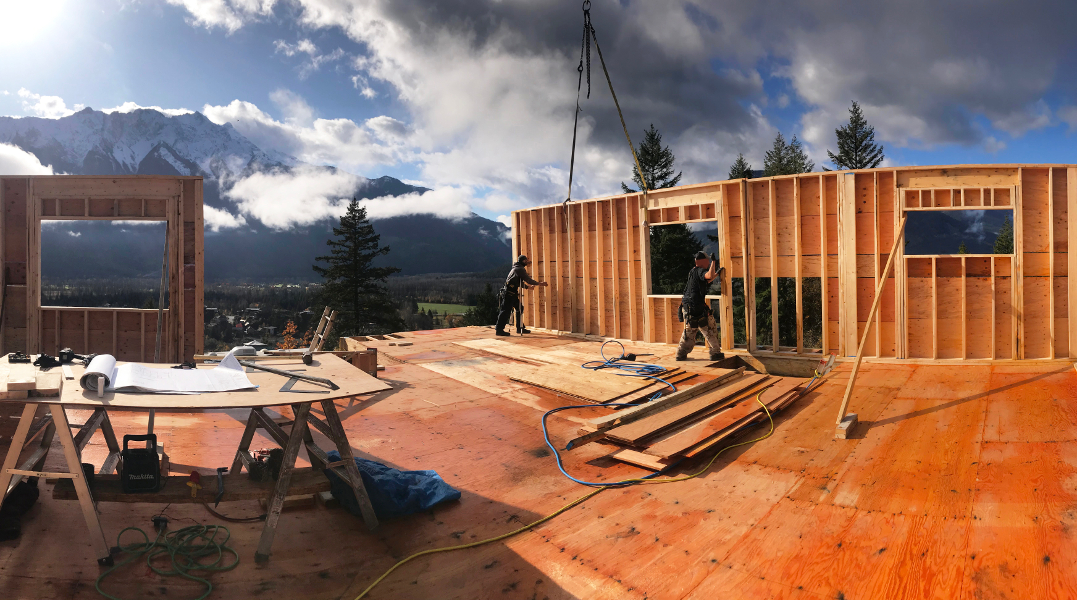If you thought it was stressful renovating a kitchen or building a new home during normal times, try doing it during a global pandemic. Here’s what you need to know about building during a uniquely challenging era.
By Andrew Findlay
A couple (let’s call them Bob and Sue) relocating from North Vancouver to Black Creek on Vancouver Island are finding it a bit of a roller-coaster ride to build a new home in B.C. these days. Fluctuating prices for lumber, steel, and other building materials have increased the cost of Bob and Sue’s 2,500-square-foot home near Miracle Beach by roughly 30 per cent–a familiar scenario over the past 16 months. Luckily, Bob and Sue have the financial means to absorb the price spike. Like everyone who broke ground on a new build or started a renovation over the past year in B.C., they found themselves facing delay, supply-chain and cost issues, thanks to the double whammy of pandemic-induced disruptions and a building boom that nobody saw coming.
At the same time, builders have to juggle the multiple challenges of keeping projects on schedule and on budget, accounting for not only delays and cost overages, but an ongoing shortage of skilled and experienced labour. Contractors had to manage the expectations of anxious customers biting their fingernails as they watched the cost of their dream home change. It has made for lucrative, but also hectic, times in the construction business.
THE PERFECT STORM
When the pandemic closed things down in March 2020, lumber mills shuttered temporarily, raising prices (which have since come down). At the same time, many homeowners found themselves sitting on a pile of cash that they had earmarked for a ski holiday, a spring getaway, or other discretionary spends now rendered impossible. Unable to travel and stuck at home, consumers started tackling long-delayed renovations. Others decided to convert some space into home offices.
Then there came a real estate investment exodus from city to small-town B.C., quite unlike anything the province had experienced before. People sitting on millions of dollars in urban real estate equity started cashing out and sparking property and building frenzies from Cumberland to Revelstoke, and pretty much any other lifestyle- and recreation-rich community in between.
BUILDING CONFIDENCE
Strategies for smoother building during a pandemic.
- Research your builder carefully: speak to references, look at past projects and meet key personnel to assure a good fit of personalities and communication styles.
- From the start, list your new-home “must-haves” and “nice-to-haves,” making later decisions and trade-offs less challenging.
- If your builder anticipates price increases, choose and purchase as many materials and finishes as early as possible.
- Have a healthy contingency fund and a level-headed expectation of some budget overruns.
- Schedule regular check-ins with your builder or contractor to revisit timelines and budgets as necessary.
- Remember that you are building value, with a potentially higher assessment on homes built in a rising market.

BUILDING VALUE
The result: building contractors, even those serving smaller centres and remote areas, have been busier than ever–and so have building suppliers. At one point, the cost of 2x4s more than tripled, for example. “And it’s not just lumber. Everything has gotten more expensive,” says Scott Torry, who heads up estimating and procurement for Courtenay’s AFC Construction. “We had been going through a boom for the past few years, but I don’t think anyone saw this coming.”
AFC does both commercial and custom residential builds. Most of the company’s clients, whether commercial, government or affluent homeowners, are able to budget for cost increases. Still, Torry says price spikes and shortages demanded extra attention to tracking and adjusting costs throughout the life of a project from bid to lock-up. “We’ve had to keep refreshing budgets and doing price-checks throughout the builds,” Torry says.
The experience has been the same for Kelowna-based Fawdry Homes, according to company director Chris Freer. He says open and ongoing communication with clients has been more important than ever. “We had some budgets that were up to $300,000,” or 15 to 30 per cent of the project total, Freer says. That means soaring stress levels for clients who may be making the biggest investments of their lifetimes.
Consequently, builders like Fawdry were spending way more time than usual with creative budgeting, a task made more challenging when many clients have inadequate or exhausted contingency funds. Patience is a must, Freer says, in this current environment. For customers, doing their homework at the front end and getting it right in the design phase can ease the stress. So can hiring a design consultant to help with product and material selections. “Do your homework and find a builder you can trust,” Freer says. The silver lining to this crazy building environment? The average home appraisal, when new-home clients finally move in, is way up, says Freer. And that means more home equity that clients can hopefully bank on in the future.
MANAGING A BOOM
Erin Page, a marketing and communications manager for Dilworth Homes, says after the initial uncertainty of the pandemic, the company saw a big uptick in the Okanagan real estate market, with an influx of buyers from the Lower Mainland, Alberta, Saskatchewan and Ontario. The pandemic has also brought an unprecedented wave of remote-working home buyers, people who can live in the Okanagan “but maintain employment elsewhere,” Page says.
Throughout the pandemic, Dilworth has worked closely with trade and material suppliers to keep price increases in check and to plan for increased lead times. “We were able to order materials in advance and mitigate the effect on customers,” Page says. “Thankfully over the past few weeks, we’ve watched the cost of lumber trend down, which is a relief to both builders and customers alike.”
This boom time for builders is also spotlighting a chronic challenge for the sector: finding skilled and reliable trades people and apprentices. Like most builders, AFC, Fawdry, and Dilworth have had to double down on recruitment and training. “There’s also been a shortage of good staff; now it’s worse,” says Freer. “It definitely slows down the quality builders who won’t hire just anyone.”
Scott Torry at AFC Construction says their staffing strategy has been to bring in new journeymen and apprentices and train them in-house. “If there’s someone who aspires to be a project manager, then we’ll help them build up the skills and experience to get there,” Torry says. “For sure, if we find an experienced tradesperson who’s moving to the area… we’re more than willing to hire.”
Back at Dilworth’s head office, Erin Page has one key piece of advice for anyone in the market to build a new house or an addition. “Partner with a long-term builder that values open, honest communication,” she says. That’s advice that holds true, pandemic or no pandemic.



